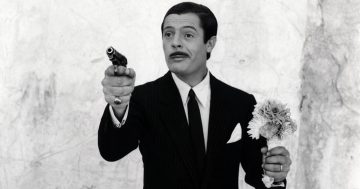Georges Méliès and the Magic of the Cinema
Film Art
We could make this publication thanks to small donations. How is 3 minutos de arte supported?
Georges Méliès and the Magic of the Cinema
Georges Méliès was the master of imagination in the early cinema. He was the one who added special effects, illusionism, and fantasy to those first short films that astonished the public. Usually, they were just scenes taken from reality, such as a locomotive arriving at a station or the departure of workers from a factory. Méliès was the creator of the magic of the cinema.
When he was a child, he was amazed by the performance of the great magician of his time: Jean Eugène Robert-Houdin (from whom the famous Houdini would later take his name). Years later, he bought that magician’s theater to produce illusionist shows himself. Méliès was in charge of the sets, the scenery, and the machinery to generate the illusions. And even before knowing about the cinema created by the Lumière brothers, one of the most amazing shows of his theater was the projection of slides with very exotic scenes on a large screen.
Then, he knew the cinema, at the first public projection of the Lumiére Brothers in 1895, and in addition to being enthusiastic about its creative potential, he also saw the enormous economic potential for his theater. But the Lumière brothers did not sell him a camera, and when he failed to “invent” one himself, he had to buy a similar device from another inventor named Robert William Paul.
From that moment on, not only did he start creating films one after another (he filmed about 500), but he was also the one who built the first film studio in history (to be able to continue filming regardless of the inclement weather). A studio that had a lot of devices to generate amazing visual tricks.
With his background in theater and magic, Méliès filmed scripted stories with plots, which included the first montages (linear, without altering temporality, but still the first). He also produced fabulous sets that recreated unexplored or fantastic worlds and also developed tricks that generated illusions and dazzling special effects.
One of the best known tricks is the stop trick, which consists of stopping the camera, taking out a person or object, and shooting again, generating the illusion of a disappearance. Another is that of multiple exposure: filming different elements of the scene over and over again on the same film, which allowed him to multiply objects or people. But Mélès not only made people disappear, or turned them into skeletons, for example, or multiplied himself seven times, but also made his head explode, or made clothes move around the room by themselves in a haunted inn, or made heads float in the air.
And as if that were not enough, he also worked magic by coloring some of his films with the laborious technique of hand-coloring, frame by frame.
Georges Méliès did not invent cinema, but he was the one who invented everything that turned cinema into a marvel.
Image: one of the emblematic scenes of A Trip to the Moon (Georges Méliès, 1902)
Representative films:
Card party (1896)
The House of the Devil (1896)
The Haunted Castle (1897)
A Twentieth Century Surgeon (1897)
The Four Troublesome Heads (1898)
The One-Man Band (1900)
A Trip to the Moon (1902)
The Man with the Rubber Head (1901)
The Kingdom of the Fairies (1903)
The Impossible Voyage (1904)
The 400 Tricks of the Devil (1906)
The Conquest of the Pole (1912)
Recommended links:
The Three Beginnings of Cinema.
Charles Chaplin and his character Charlot.
The First Comedy Film of the History of Cinema.
You can also find more material using the search engine.




0 Comments